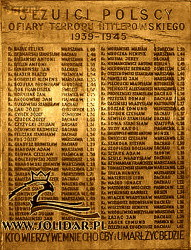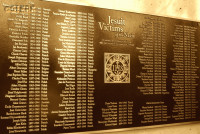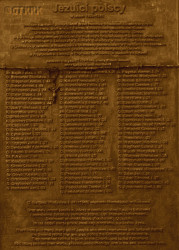Roman Catholic
St Sigismund parish
05-507 Słomczyn
85 Wiślana Str.
Konstancin deanery
Warsaw archdiocese, Poland
full list:
displayClick to display full list

searchClick to search full list by categories
wyświetlKliknij by wyświetlić pełną listę po polsku

szukajKliknij by przeszukać listę wg kategorii po polsku

Martyrology of the clergy — Poland
XX century (1914 – 1989)
personal data

surname
CAG
forename(s)
Joseph (pl. Józef)
function
laybrother
creed
Latin (Roman Catholic) Church RCmore on
en.wikipedia.org
[access: 2014.09.21]
congregation
Society of Jesus SImore on
en.wikipedia.org
[access: 2014.09.21]
(i.e. Jesuits)
diocese / province
Lesser Poland Province SI (from 1926)
date and place
of death
13.05.1945

AL Gablonzsub‐camp of KL Groß‐Rosen concentration camp
today: Rýnovice, district of Jablonec nad Nisou, Jablonec nad Nisou dist., Liberec reg., Czechia
more on
en.wikipedia.org
[access: 2022.05.02]
alt. dates and places
of death
KL Groß‐Rosenconcentration camp
today: Rogoźnica, Strzegom gm., Świdnica pov., Lower Silesia voiv., Poland
more on
en.wikipedia.org
[access: 2019.02.02]
details of death
After German and Russian invasion of Poland in 09.1939 and start of the World War II, after start of German occupation, arrested on 24/25.09.1944 by the Germans.
Jailed in Montelupich Str. prison in Kraków.
From there on 17.12.1944 transported to KL Groß‐Rosen concentration camp.
From the main camp transported to its branch (Germ. Außenlager) AL Gablonz.
There, in the town of Rynowice, near Jablonec nad Nisou, slaved for the German company Feinapparatenbau GmbH, belonging to the Carl Zeiss Jena concern, in a special industrial zone built by the Germans after the capture of Czechoslovakia in 1938.
The sub–camp was established in 11.1944 and the prisoners worked in the production of parts aircraft and weapons.
The camp was evacuated on 08.05.1944, when the Germans took the prisoners out under guard in a column.
Immediately afterwards, the entire group was handed over to the Red Cross and Czech partisans.
Until then survived, but shortly afterwards, due to exhaustion, perished.
prisoner camp's numbers
85134 (KL Groß‐RosenClick to display the description)
cause of death
extermination: murder / exhaustion
perpetrators
Germans
sites and events
KL Groß‐RosenClick to display the description, Cracow (Montelupich)Click to display the description, GeneralgouvernementClick to display the description, Ribbentrop‐MolotovClick to display the description, Pius XI's encyclicalsClick to display the description
date and place
of birth
08.02.1912

Błażowatoday: Błażowa gm., Rzeszów pov., Subcarpathia voiv., Poland
more on
en.wikipedia.org
[access: 2021.05.06]
religious vows
1934 (temporary)
positions held
1937 – 1944
friar — Krakówtoday: Kraków city pov., Lesser Poland voiv., Poland
more on
en.wikipedia.org
[access: 2021.06.07] ⋄ monastery, Jesuits SI — monastery cook
16.01.1932
accession — Stara Wieśtoday: Brzozów gm., Brzozów pov., Subcarpathia voiv., Poland
more on
en.wikipedia.org
[access: 2021.12.18] ⋄ Assumption of the Blessed Virgin Mary monastery, Jesuits SI
others related
in death
BŁĄDZIŃSKIClick to display biography Vladislav, BOGACZClick to display biography Adalbert, CAPClick to display biography Alexander, CHMIELNICKIClick to display biography Sigismund, DRYGASClick to display biography Francis, DRYGASClick to display biography John, GRYŹLAKClick to display biography Anthony, JĘDRAClick to display biography Martin, KOŚMIDERClick to display biography Adalbert, KRAJEWSKIClick to display biography Joseph, LEŃKOClick to display biography Joseph, ŁUKOWIAKClick to display biography Anthony, PLUCIŃSKIClick to display biography Valentine, PYKOSZClick to display biography John, SAROSIEKClick to display biography Witold, STOPIŃSKIClick to display biography Joseph, SZMERGALSKIClick to display biography Simon, WĄDRZYKClick to display biography Anthony, WIĘCKIEWICZClick to display biography Leo, ŻUREKClick to display biography Anthony
sites and events
descriptions
KL Groß‐Rosen: Groß‐Rosen (today: Rogoźnica) was a German Germ. Konzentrationslager (Eng. concentration camp) KL, founded in the summer of 1940 (first transport of prisoners arrived on 02.08.1940). Initially a branch of KL Sachsenhausen concentration camp. In 1944 became a centre of a network of more than 100 camps. Prisoners were forced to slave at nearby granite quarries, on starvation rations. More than 125,000 prisoners were enslaved — 40,000 victims perished. In 1945 — in „death marches” — Germans dragged through the camp thousands of prisoners from the camp’s in east being one by one overrun by the Russians. The camp itself was captured by the Russians on 14.02.1945. (more on: www.gross-rosen.euClick to attempt to display webpage
[access: 2021.07.18], en.wikipedia.orgClick to attempt to display webpage
[access: 2019.02.02])
Cracow (Montelupich): Cracow penal prison, during occupation run by the Germans — from 28.02.1941 by Germ. Geheime Staatspolizei (Eng. Secret State Police, known as Gestapo. In 1940‐1944 Germans jailed there approx. 50,000 prisoners, mainly Poles and Jews. Some of them were transported to KL Auschwitz concentration camp, some were executed. After cease in war effort the prison was used by UB — a Polish unit of Russian NKVD — as a prison for Polish independence resistance fighters, some of which were subsequently sent to prisons and slave labour camps in Russia. (more on: en.wikipedia.orgClick to attempt to display webpage
[access: 2014.10.31])
Generalgouvernement: After the Polish defeat in the 09.1939 campaign, which was the result of the Ribbentrop‐Molotov Pact and constituted the first stage of World War II, and the beginning of German occupation in part of Poland (in the other, eastern part of Poland, the Russian occupation began), the Germans divided the occupied Polish territory into five main regions. In two of them new German provinces were created, two other were incorporated into other provinces. However, the fifth part was treated separately, and in a political sense it was supposed to recreate the German idea from 1915 (during World War I, after the defeat of the Russians in the Battle of Gorlice in 05.1915) of creating a Polish enclave within Germany. Illegal in the sense of international law, i.e. Hague Convention, and public law, managed by the Germans according to separate laws — especially established for the Polish Germ. Untermenschen (Eng. subhumans) — till the Russian offensive in 1945 it constituted part of the Germ. Großdeutschland (Eng. Greater Germany). Till 31.07.1940 formally called Germ. Generalgouvernement für die besetzten polnischen Gebiete (Eng. General Government for the occupied Polish lands) — later simply Germ. Generalgouvernement (Eng. General Governorate), as in the years 1915‐1918. From 07.1941, i.e. after the German attack on 22.06.1941 against the erstwhile ally, the Russians, it also included the Galicia district, i.e. the Polish pre‐war south‐eastern voivodeships. A special criminal law was enacted and applied to Poles and Jews, allowing for the arbitrary administration of the death penalty regardless of the age of the „perpetrator”, and sanctioning the use of collective responsibility. After the end of the military conflict of the World War UU, the government of the Germ. Generalgouvernement was recognized as a criminal organization, and its leader, governor Hans Frank, guilty of war crimes and crimes against humanity and executed. (more on: en.wikipedia.orgClick to attempt to display webpage
[access: 2024.12.13])
Ribbentrop‐Molotov: Genocidal Russian‐German alliance pact between Russian leader Joseph Stalin and German leader Adolf Hitler signed on 23.08.1939 in Moscow by respective foreign ministers, Mr. Vyacheslav Molotov for Russia and Joachim von Ribbentrop for Germany. The pact sanctioned and was the direct cause of joint Russian and German invasion of Poland and the outbreak of the World War II in 09.1939. In a political sense, the pact was an attempt to restore the status quo ante before 1914, with one exception, namely the „commercial” exchange of the so‐called „Kingdom of Poland”, which in 1914 was part of the Russian Empire, fore Eastern Galicia (today's western Ukraine), in 1914 belonging to the Austro‐Hungarian Empire. Galicia, including Lviv, was to be taken over by the Russians, the „Kingdom of Poland” — under the name of the General Governorate — Germany. The resultant „war was one of the greatest calamities and dramas of humanity in history, for two atheistic and anti‐Christian ideologies — national and international socialism — rejected God and His fifth Decalogue commandment: Thou shall not kill!” (Abp Stanislav Gądecki, 01.09.2019). The decisions taken — backed up by the betrayal of the formal allies of Poland, France and Germany, which on 12.09.1939, at a joint conference in Abbeville, decided not to provide aid to attacked Poland and not to take military action against Germany (a clear breach of treaty obligations with Poland) — were on 28.09.1939 slightly altered and made more precise when a treaty on „German‐Russian boundaries and friendship” was agreed by the same murderous signatories. One of its findings was establishment of spheres of influence in Central and Eastern Europe and in consequence IV partition of Poland. In one of its secret annexes agreed, that: „the Signatories will not tolerate on its respective territories any Polish propaganda that affects the territory of the other Side. On their respective territories they will suppress all such propaganda and inform each other of the measures taken to accomplish it”. The agreements resulted in a series of meeting between two genocidal organization representing both sides — German Gestapo and Russian NKVD when coordination of efforts to exterminate Polish intelligentsia and Polish leading classes (in Germany called «Intelligenzaktion», in Russia took the form of Katyń massacres) where discussed. Resulted in deaths of hundreds of thousands of Polish intelligentsia, including thousands of priests presented here, and tens of millions of ordinary people,. The results of this Russian‐German pact lasted till 1989 and are still in evidence even today. (more on: en.wikipedia.orgClick to attempt to display webpage
[access: 2015.09.30])
Pius XI's encyclicals: Facing the creation of two totalitarian systems in Europe, which seemed to compete with each other, though there were more similarities than contradictions between them, Pope Pius XI issued in 03.1937 (within 5 days) two encyclicals. In the „Mit brennender Sorge” (Eng. „With Burning Concern”) published on 14.03.1938, condemned the national socialism prevailing in Germany. The Pope wrote: „Whoever, following the old Germanic‐pre‐Christian beliefs, puts various impersonal fate in the place of a personal God, denies the wisdom of God and Providence […], whoever exalts earthly values: race or nation, or state, or state system, representatives of state power or other fundamental values of human society, […] and makes them the highest standard of all values, including religious ones, and idolizes them, this one […] is far from true faith in God and from a worldview corresponding to such faith”. On 19.03.1937, published „Divini Redemptoris” (Eng. „Divine Redeemer”), in which criticized Russian communism, dialectical materialism and the class struggle theory. The Pope wrote: „Communism deprives man of freedom, and therefore the spiritual basis of all life norms. It deprives the human person of all his dignity and any moral support with which he could resist the onslaught of blind passions […] This is the new gospel that Bolshevik and godless communism preaches as a message of salvation and redemption of humanity”… Pius XI demanded that the established human law be subjected to the natural law of God , recommended the implementation of the ideal of a Christian state and society, and called on Catholics to resist. Two years later, National Socialist Germany and Communist Russia came together and started World War II. (more on: www.vatican.vaClick to attempt to display webpage
[access: 2023.05.28], www.vatican.vaClick to attempt to display webpage
[access: 2023.05.28])
sources
personal:
college.holycross.eduClick to attempt to display webpage
[access: 2012.11.23], www.bj.uj.edu.plClick to attempt to display webpage
[access: 2012.11.23], www.straty.plClick to attempt to display webpage
[access: 2015.04.18], inpersonachristiadmajoremdeigloriam.blogspot.comClick to attempt to display webpage
[access: 2013.08.17], archive.todayClick to attempt to display webpage
[access: 2021.12.19]
bibliographical:
„Jesuits on Polish and Lithuanian territory knowledge encyclopedia, 1564‐1995”, Fr Louis Grzebień SI (editor), WAM Printing House, Cracow 1996
„A martyrology of Polish clergy under German occupation, 1939‐1945”, Fr Szołdrski Vladislaus CSSR, Rome 1965
„Martyrdom of the Polish clergy 1939‐1956”, Bp Bohdan Bejze, Antoni Galiński (ed.) – collection, Łódź Archdiocesan Publishing House, Łódź 1992
original images:
www.sowiniec.com.plClick to attempt to display webpage
[access: 2016.03.14], college.holycross.eduClick to attempt to display webpage
[access: 2013.05.19], www.miejscapamiecinarodowej.plClick to attempt to display webpage
[access: 2014.05.09]
LETTER to CUSTODIAN/ADMINISTRATOR
If you have an Email client on your communicator/computer — such as Mozilla Thunderbird, Windows Mail or Microsoft Outlook, described at WikipediaPatrz:
en.wikipedia.org, among others — try the link below, please:
LETTER to CUSTODIAN/ADMINISTRATORClick and try to call your own Email client
If however you do not run such a client or the above link is not active please send an email to the Custodian/Administrator using your account — in your customary email/correspondence engine — at the following address:

giving the following as the subject:
MARTYROLOGY: CAG Joseph
To return to the biography press below:
 Click to return to biography
Click to return to biography










